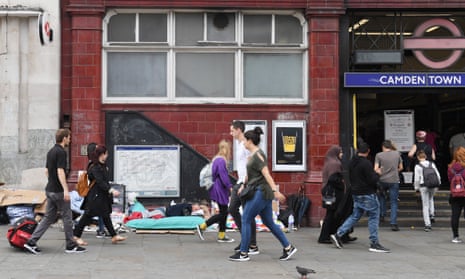The most maddening and self-defeating aspect of the Brexit mess is that it consumes political energy and media coverage that is desperately needed elsewhere. More than anything, it is needed by the hundreds of thousands of people in Britain who do not have adequate homes, and most urgently by the estimated 4,500 people who are sleeping on the streets of British cities each night. It only takes a short stroll through any city centre to see that this country is in the grip of a crisis – rough sleeping has increased by an estimated 134% since a Tory-led coalition took power in 2010, according to National Audit Office figures. The lack of any big policy initiative aimed at getting a grip on this situation – or indeed any real public debate on the issue – is a national disgrace.

Tamsen Courtenay’s shocking, witty and humane book cuts straight through the distraction and denial. Every politician in the country should be strapped to a chair and forced to read it. Courtenay’s background in investigative journalism – she used to work for Panorama and Dispatches – is largely irrelevant here, as it wasn’t exactly difficult to uncover this story; it stares many of us in the face when we step out of our doors. As she writes: “What particularly struck me about the homeless was that their lives are indeed secret but they are not hidden – quite the reverse – they are there, in ever-growing numbers, for everyone to see.”
This is the strange situation that Courtenay sets out to expose and explore. Despite the fact that street homeless people are so visible – they live every minute of their days in public – we often don’t really see them. Perhaps they make us feel helpless, and remind us how fragile life can be. “It’s because people have got a thing about problems,” Charisse, a 37-year-old homeless woman says, describing how most people don’t even look down when they pass her on the pavement. “My problem is out there, in their face. Everybody has problems but they tend to keep them in a little box, locked up … but my problem is out there.”
The power of Courtenay’s project is its simplicity. Early one morning, she walks to the bottom of her road in Highbury, north London with her Nikon camera in a plastic bag and a policy of talking to any homeless person who will talk to her. For a few weeks she does this every day, making her way slowly towards the West End. She sits on park benches and damp pieces of cardboard, finds people in tents and phone boxes, buys sugary coffees and shares her fags. Her aim is not to judge homeless people for their choices, but just to listen to what they have to say.
Each chapter of the book tells the story of one of the people she met, and each is heartbreaking in a different way. Darryl “Chuckie” Borden is a miracle of resilience, a 21-year-old who has been on the streets since he was discharged from the care system, aged 16. Chuckie refuses to claim any benefits because he doesn’t want anyone to be able to call him a scrounger, and spends his days on the Strand, supporting himself by selling artwork. His dream is to start a charity for disabled homeless people. “If you can’t be positive, what’s the fucking point in living?” Beth Langham, by contrast, has been all but destroyed in body and mind: Courtenay finds her “barely clothed and spinning in frantic circles … sobbing and screaming at passersby.” Her story begins with her rape by a babysitter, at the age of nine, and ends with crack addiction and prostitution.
Sometimes the stories challenge all our assumptions. Edward, who is sleeping in a tent in Regent’s Park, has a degree in marine biology and speaks four languages. He spends his days monitoring eels, reads books by Arthur Conan Doyle, and espouses Zen philosophy. Other stories are terrifyingly humdrum, and serve to show how easily homelessness can happen. Patrick O’Neil was until recently running his own pub in Folkestone: when the business failed he lost his livelihood and his home in one fell swoop.
Although homeless people are as diverse as any other group, common themes emerge. Harsh treatment by impoverished authorities is one. Charisse, who walked out on an abusive relationship with a man who had beaten her black and blue for eight years, was told that her local council wouldn’t help with housing because she had “made herself intentionally homeless”. Jane and Kenny, a couple in their 60s sleeping on a damp mattressbeneath the Waterloo Imax cinema, list heart disease, liver disease and bipolar disorder among their ailments, but are apparently “not enough of a hardship case” to qualify for help.
On the streets, the brutality is often more personal. Being beaten up and pissed on are, it seems, standard experiences for London’s rough sleepers. More than anything, though, the book’s message is that homeless people don’t just want you to chuck them a quid: they want to be seen, heard and understood. Reading Four Feet Under is a great way of starting to do that. And when you finish the book, you may feel inspired to go out and ask a few more questions yourself.

Comments (…)
Sign in or create your Guardian account to join the discussion